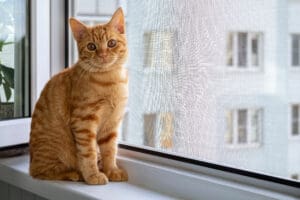In the bustling urban landscapes of New York City, our feline family members often enjoy the sights and sounds of the city from high-rise apartments. While it’s heartwarming to see your cat perched by the window, there’s a hidden danger lurking in these lofty heights – cat high-rise syndrome. We’ll explore what this term means, the potential injuries it can lead to, and some useful tips to keep your beloved cats safe.
If you have any concerns or need more information, don’t hesitate to reach out to us at (212) 924-6116.

Understanding Cat High-Rise Syndrome
Cat high-rise syndrome might seem like an odd term, as it doesn’t relate to an actual disease or illness, but it’s essential to grasp its implications. This phenomenon primarily occurs in urban environments like New York City, where high-rise buildings are common. The term itself refers to the alarming number of cat injuries resulting from falls from elevated surfaces, such as high-rise apartments.
Imagine a curious cat exploring an open window or balcony on the 10th floor. This is an excellent vantage point for the cat, but it comes with inherent risks. Cats, driven by their natural instincts to explore and observe, may misjudge distances or be startled, leading to accidental falls. With the allure of fresh air and interesting sights, cats often find themselves in situations where falling is possible.
The Limits of a Cat’s Agility
Cats possess a natural reflex that allows them to twist their bodies in mid-air to land on their feet. However, this remarkable skill is not foolproof. Cats need sufficient time and distance to execute this maneuver effectively. In cases of high falls, they may not have enough time to prepare themselves, leading to more severe injuries.
How High Can Cats Fall Without Injury?
It’s a common misconception that cats can always survive falls from great heights. In reality, once a fall surpasses a certain point, the risk of severe injury or fatality increases significantly. Generally, cats can survive falls from heights of up to five stories or around 50 feet. Beyond this point, the chances of injury or death escalate.
The Role of Terminal Velocity
Terminal velocity is a primary determining factor in a cat’s survival from falling. When a cat reaches terminal velocity, it can spread its body to increase drag, slowing down its fall. This is why cats can sometimes survive higher falls; they have more time to brace for impact.
Types of Injuries Cats Can Sustain from Falling
When we talk about the potential injuries resulting from cat high-rise syndrome, recognizing the severity and implications is helpful (and potentially life-saving). These injuries can be life-changing for cats and heartbreaking for their owners. The most common injuries include:
Broken Bones: Cats may suffer fractures, especially in their legs, pelvis, or spine, as they attempt to land on their feet during a fall.
Head Trauma: High falls can lead to head injuries, including concussions or brain damage, which can have long-term effects on a cat’s health.
Internal Injuries: Cats may sustain internal injuries, such as organ damage or internal bleeding, due to the impact of the fall.
Soft Tissue Injuries: Cats may experience soft tissue injuries, including bruising and damage to muscles or skin.
Shock and Psychological Trauma: Falling from a significant height can be a traumatic experience for cats, leading to shock and long-lasting psychological trauma.
These injuries can be painful and costly to treat. Knowing the risks is the first step in preventing them.
Risk Factors and Safety Measures
Understanding the risk factors associated with cat high-rise syndrome is essential to protect your feline companion. Some key risk factors include:
Curiosity: Cats are naturally curious creatures, and young cats, in particular, maybe more inclined to explore open windows or balconies.
Age: Older cats may have decreased vision and coordination, leading to a greater risk of misjudging height and distance. They also have more fragile bodies that cannot adjust as quickly or handle falls as well as younger, healthier cats.
Lack of Awareness: Cats may not fully comprehend the dangers of high places, making it essential for pet owners to take preventive measures.
Open Access: Leaving windows and balconies open without protective measures increases the likelihood of accidents.
Now, let’s look at some detailed safety measures to safeguard your cat:
Secure Windows and Balconies: Install sturdy screens, nets, or window locks to create a barrier that prevents your cat from accessing open windows or balconies.
Supervision: If you have an open window, keep a watchful eye on your cat to ensure they don’t get too close to the edge.
Provide Enrichment: Cats that are mentally and physically stimulated indoors are less likely to seek adventure outside. Offer toys, scratching posts, and interactive play to keep them engaged.
Consider Indoor Enclosures: For those with outdoor space, consider building a secure enclosure or “catio” where your feline friend can safely enjoy the outdoors without the risk of falling.
Talk to Us for More Advice to Keep Your Cat Safe
In New York City, where high-rises abound, cat high-rise syndrome is a very real concern for pet owners. Understanding the risks, the limits of a cat’s agility, and taking preventive measures can make all the difference for your pet. Your cat’s safety is our foremost priority at Heart of Chelsea Veterinary Group. If you have any questions or want to schedule an appointment, please call us at (212) 924-6116. Let’s work together to ensure your feline friend enjoys a safe and happy life indoors.
Recent Posts
About Us
Heart of Chelsea Veterinary Group is more than an animal hospital; we are your partner in giving your pet a lifetime of outstanding care. Our veterinarians and team members form lasting relationships with pet owners like you to create unique, personalized experiences for all. Heart of Chelsea was founded in 1999 to provide the community with a neighborhood veterinary practice that delivers thorough, compassionate medicine and unparalleled concierge client service.
